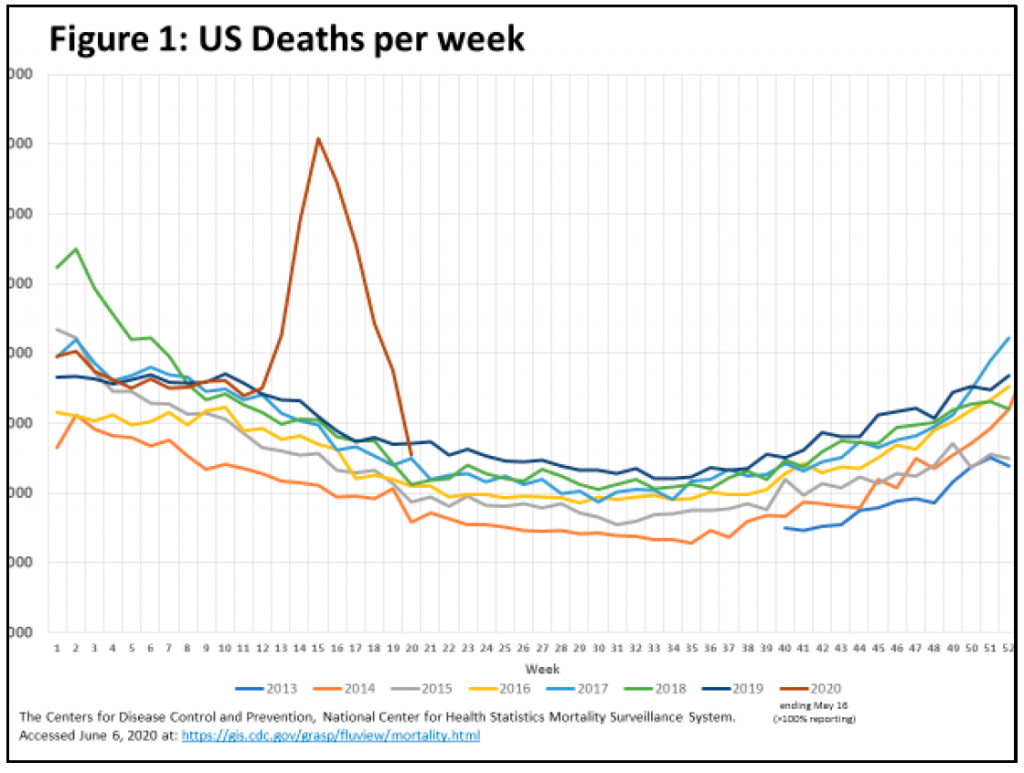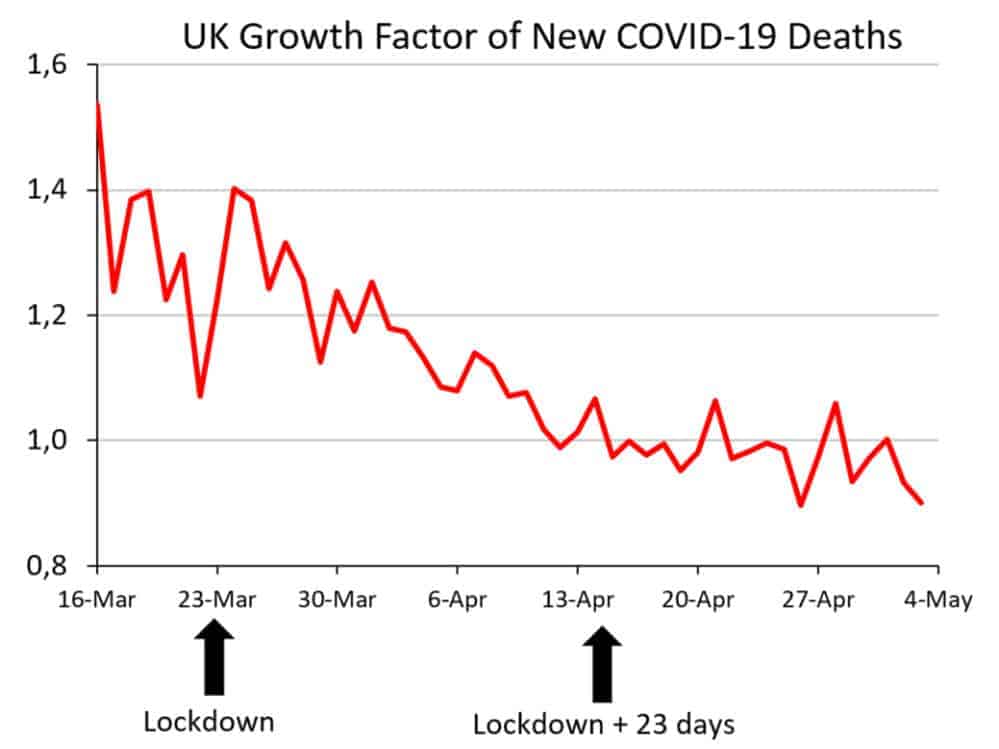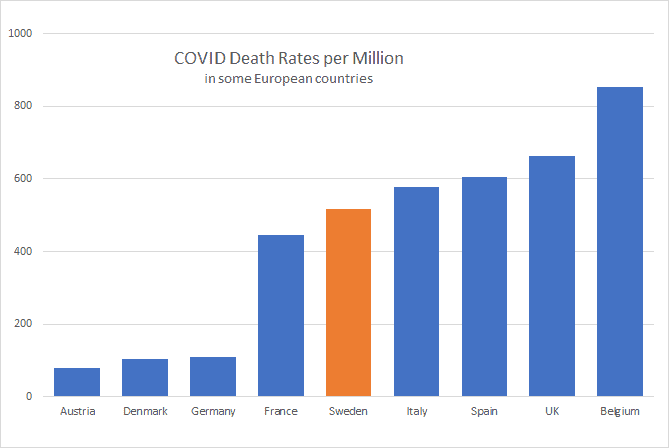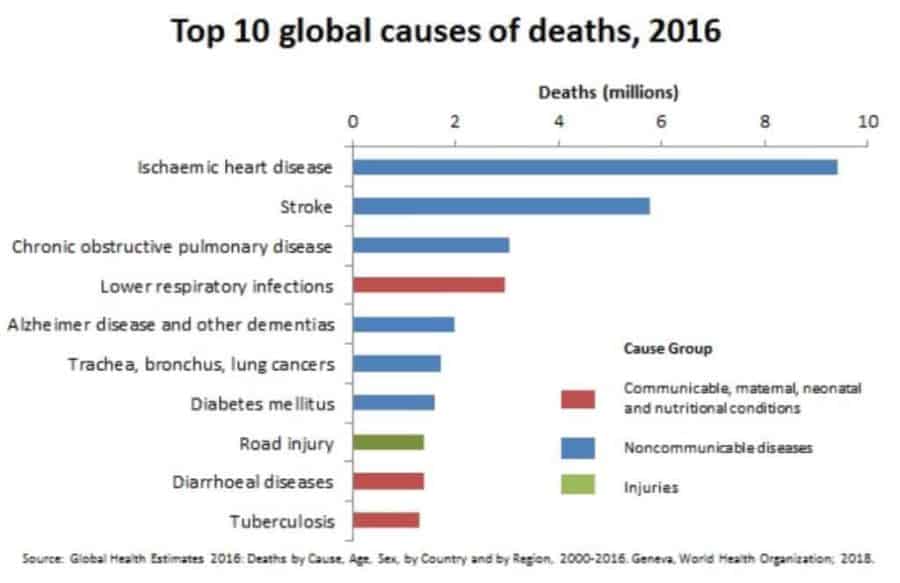Many of us are still shell-shocked by the changes in our lives that have been imposed this spring. We’re reacting to each unexpected event as it comes. But to anyone who has stepped back to make sense of this web of contradictory messages that pour out of our newsfeeds, it is clear that the government agencies and corporate news media are slanting their message toward fear. I am particularly concerned when they do this at the expense of honesty. This is a moment for the scientific community to be engaging in spirited dialog among diverse voices. Only with open debatei can we hope to shed light to guide the momentous public policy decisions that are being made, directing our culture and global economy into unexplored territory. But instead of robust debate, what I see is a monolithic message, and censorship of the few brave scientists who dissent from that message. I’m ashamed to say that the scientific community has been part of the problem.
I’m writing here about two issues:
(1) Numbers reported by CDC have been gamed to make it appear that America is in the second wave of a pandemic. Instead of reporting COVID deaths, they began reported COVID cases. Then they conflated recovered individuals (who test positive for antibodies) with current cases (who test positive for the active virus). No wonder numbers are rising!
(2) A new report featured prominently in Nature purports to show that lockdowns have stemmed the spread of the virus and have saved lives. The article is by the same team whose flawed models produced apocalyptic predictions last March that justified lockdowns in Europe and the US. The new computer model assumes from the start that the number of COVID deaths would have expanded exponentially from their March levels, and that social distancing is the only factor responsible for lower death rates. That is, it assumes exactly what it purports to prove. Where is accountability? Why is this perspective promoted in the world’s most prestigious journal, while reasonable doubts are swept aside?
The global death rate from COVID-19 is down to about 4,000 per day. It is not even among the top ten causes. COVID is lower than traffic deaths, lower than diarrhea. Even compared to other respiratory infections, COVID is now a minority.
In the US, daily COVID deaths peaked in April, and are now down to 1/10 the peak rate, at about 400/day. COVID is now the sixth leading cause of death in America, but it no longer registers as a bump in total mortality.


But the headlines claim we are in the midst of a “second wave”, based on reported numbers of cases.

Deaths from COVID are being over-reported. Hospitals are incentivized to diagnose COVID with Medicare reimbursement rates that are higher than other diseases, and guaranteed coverage from every major insurer. Doctors are being instructed to report COVID as a cause of death when no testing is done, and when chronic illnesses contributed to the outcome. And with all this, the number of deaths continues to fall, even as the reported number of cases is rising. Why is this?
In part, the lower fatality rate is real. Doctors are learning from experience how to treat the disease. More chloroquine and zinc, less intubation. Like all viruses, this one is evolving toward greater contagion and lower lethality. But the most important explanation is an artifact in the way COVID cases are being reported. Before May 18, the “case count” was based on tests for the live virus, and counted only sick people. Then the definition was changed to count both people who tested positive for the virus and for antibodies to the virus. The latter group is mostly people who have recovered from COVID, or who developed antibodies with exposure. As the number of recovered patients increases, of course the rate of positive tests will increase.
In the past, Neil Ferguson’s group at Imperial College of London has produced scary computer models that overestimated the epidemics of Hong Kong Flu, Mad Cow Disease, Avian Flu, Swine Flu, and the 2003 SARS outbreak. In March, his group’s computer model was justification for England, Europe and America to shut down economies, prevent people talking and meeting, prohibit concerts and theater and church and every kind of public gathering, throw tens of millions of people out of work, deny the rights to freedom of assembly that are fundamental to democratic governance. His manuscript was not even peer reviewed, but only posted on a university server. Even before its details and assumptions were made known, the integrity of the model was assailed by other experts, including Stephen Eubank (UVA Biocomplexity Institute) and Yaneer Bar-Yam (New England Complex Systems Inst). After details of the assumptions were revealed at the end of April, the model was widely scorned by real experts (e.g. Andrew Gelman) and self-appointed pundits (Elon Musk).
I have enough experience with computer models to know that results are often highly leveraged with respect to details of the input. Sensitivity analysis is essential for interpreting results, but is almost never done. Too often, the output is reported without the qualification that small changes to the input produce very different results.
Against this background, the high-profile publication in Nature of Ferguson’s recent work is suspicious. I would have thought he had no credibility left among serious modelers of epidemiology, but I have ceased to be surprised when politics trumps competence for access to the most prestigious publication venues.
The Ferguson Article Vindicating Lockdown
They analyze spread of COVID in 11 Eurpoean countries this Spring, averaging over different countries but not contrasting the different local strategies. They take death counts as surrogate for case counts because reports of case counts are even more unreliable than death counts. But (one of several crucial failures) they don’t apply a time lag between death counts and case counts.
They take as input for each country the dates on which each of three different isolation strategies was implemented. They assume that the virus would have spread exponentially but for these measures, and credit the isolation measures with the entire difference between reported death rates and the theoretical exponential curve.
They conclude that Europe has dodged a bullet, that less than 4% of people had been infected, and by implication the lockdown has saved the other 96%. They imply but don’t state explicitly that there would have been about 4 million deaths in Europe instead of ~150,000 reported when the paper was written.
It is obvious that lockdown and social isolation slow the spread of the disease, but not obvious that they affect the eventual reach of the disease. Thus it is an open question whether the public policy prevented or only delayed deaths from COVID. This question can be addressed most directly by comparing regions that were locked down with regions that remained open. Instead of doing this, the Ferguson group lumped all regions together and compared their results with an unrealistic scenario in which the exponential curve would have expanded to infect every susceptible person in Europe.
Two schools of thought
There are fundamentally two hypotheses about the epidemiological events of this spring: Either the number of people exposed has been high and the fatality rate low, or else the number of people exposed has been low and the fatality rate higher. People in the first camp argue that the exposed population is over 50% in Europe and America, approaching or exceeding herd immunity, and the population death rate is in the range 0.0005. In the second camp, people estimate the population exposure about ten times lower (5%) and the fatality rate correspondingly higher (0.005).
The story told by people in the first camp is that social distancing slowed but did not prevent transmission of the disease through the population. By now, the presence of the virus is waning because people in many places have already been exposed.
The story of Ferguson and others in the second camp is that social distancing actually stopped spread of the virus, so that most people in Europe and American have never been exposed. It follows that if we ease restrictions, there is another wave of infections ahead, potentially 20 times larger than the first wave.
The deep flaw of the recent Ferguson paper is that his team does not consider the first scenario at all. Built into their model, they assume that population level immunity is negligible, and the only thing that has slowed spread of the virus has been social distancing. This is where they put the rabbit in the hat.
If they had considered the alternative hypothesis, how would it have compared?
To choose between the two hypotheses, we might compare a region before and after lockdown, or we might compare regions that locked down with regions that didn’t.
In a preprint response to Ferguson, Homburg and Kuhbandner do a good job with the first approach. They take Ferguson to task for not considering the immunity that spreads through the population along with the disease. They show that exponential expansion had already slowed in England before the effect of the lockdown on mortality data could have been felt.

Lockdown went into effect in Britain on March 23. If lockdown had a benefit, it would be in preventing new cases, and its effect on the death rate would show up about 23 days later (April 14), because 23 days is the median time to fatality for those patients who die of COVID. In the graph, we see that the death rate had already leveled off by April 14.

On this log graph, an exponential increase would appear as a straight line sloping upward. It’s clear that the exponential expansion phase ended long before the lockdown could have had any effect. Not only weren’t the numbers expanding exponentially, but the death rate had already started to decline before April 14, when the effect of lockdown was expected to kick in. The authors state they performed the same analysis for 10 other countries in the Ferguson study with similar results, though they show the graph for Great Britain alone.
“We demonstrate that the United Kingdom’s lockdown was both superfluous and ineffective.”
— [Homburg and Kuhbandner]
Here in the US, there was a natural experiment when people emerged into the streets to protest racism and police brutality at the end of May. Social distancing in this environment has been impossible. Allowing for a 23-day lag, we should have seen a surge in US mortality starting mid-June. In the plot below, there appears to be a leveling off of the death rate since mid-June, but no new disaster. This alone is strong evidence that US has substantial herd immunity, and that most of the population has already been exposed to the virus.

A second way to distinguish between the two hypotheses is to compare regions that locked down with regions that didn’t. One of their 11 European countries was Sweden, where the economy was kept open and quarantine was limited to people who were symptomatic with COVID. It is a glaring defect in the Nature paper that Sweden is lumped in with the other ten countries when it should have been contrasted. In fact, the mortality curve for Sweden was typical for the other ten countries, even as commercial and cultural institutions in Sweden continued normal operations. Sweden has had a higher death rate than Austria, Germany, France, and Denmark, but lower than Belgium, Italy, Spain, or UK. There is no evidence that Sweden’s COVID mortality was higher for having bucked the trend to remain open, but some indication that Germany and Austria had particularly effective containment policies.

We can ask the same question of the different states in the USA. Comparing death rates from COVID in the 42 states that locked down with 8 states that did not lock down, this article finds that the death rates in locked down states was 4 times higher. (Caveat: there was no correction for urban vs rural or for demographic differences.) The author concludes, “With the evidence coming in that the lockdowns were neither economically nor medically effective, it is going to be increasingly difficult for lockdown partisans to marshal the evidence to convince the public that isolating people, destroying businesses, and destroying social institutions was worth it.”
I’ve prepared a comparison of all states ranked by COVID mortality which you can view here.
The Politics of COVID
In 1933, Roosevelt told America we had nothing to fear but fear itself. It is common for government leaders to dispel panic because they know that a nation can better thrive when people feel confident and secure. Even G.W. Bush responded to the terror attacks of 9/11 by telling the American people, “keep shopping.” On the other side, despots sow fear in their subjects when they want to consolidate autocratic power, and when they want to stir up fervor for war.
It is clear from messaging in the corporate media that the COVID pandemic is being hyped to create more fear than is warranted.
- The fatality rate was vastly overestimated initially, and even now is probably overestimated at 0.002 to 0.005
- Doctors were told to report deaths from COVID without proof that COVID was the cause
- Reimbursement incentives for hospitals to diagnose COVID
- Repeated warnings of a second wave, etc, which has not materialized.
- Suppression of tests for well-studied, cheap treatments (chloroquine) while jumping into large-scale tests of vaccines that have not yet been tested on animals.
- No mention of vitamin D, which is a simple, cheap, and effective way people can lower their risk. [ref, ref, ref]. Our own CDC is silent, while the British equivalent agency actively discourages vitamin D for COVID prevention.
- The biggest scandal of all is that lockdown has been authorized in the US and elsewhere based on hypothetical safety benefits with no consideration of costs. Our health is affected by our communities, our cultural lives, our social lives, and our livelihoods. [Yale epidemiologist David Katz politely makes this point.]
Shamefully, the scientific community has been complicit in the campaign of fear. A handful of courageous doctors and epidemiologists have been outspoken. In addition to Katz, John Ioannidis and Knut Wittkowski are best known to me. But the most trusted journals continue to publish articles that are based on politics rather than sound science.
Who is benefiting from the international panic? Who is behind the media campaign and the distortion of science, and what is their intention?
I invite people who are more politically astute than I to speculate on these questions.


